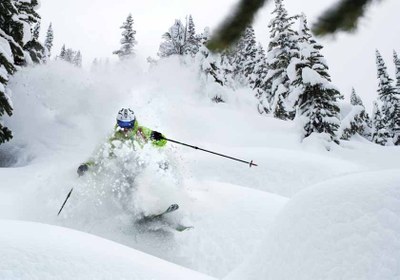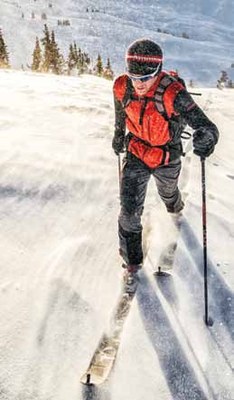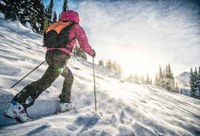By Donny Roth, Dynafit Athlete and Professional Ski Guide
Don’t slip! Be careful! Be safe. How many times have you said these words? and yet, do they really help the situation? they elevate awareness levels, which might be good, but if your attention is not properly directed, it may make matters worse. Skiing in the backcountry—the mountains beyond the ski resort boundaries—becomes more popular with each season. the industry and the experts are all now trying to get people to “Be responsible.” What exactly does this mean?
If you are skiing in a place where the ski patrol does not work, you are in the backcountry. It does not matter if it is five feet outside the resort boundary, or the most remote place in Alaska. Everyone understands that the ski patrol is there as a rescue service of sorts; they are there to pick up injured people. They also do a tremendous amount of work to prevent incidents. They do avalanche control work, mark hazards, and tell people to slow down or be aware of a particular hazard. In the backcountry, there is no ski patrol.
You’re on your own, so be responsible.
Being responsible for yourself in the backcountry means understanding the skill level and motivation of your group; picking an objective that is appropriate and considers the real hazards; planning and preparing properly; and finally, making sound, rational decisions while traveling.
Take an avalanche safety and awareness course. If you haven’t taken a Level I avalanche course in the last three years or so, take another one. After you’ve completed an avalanche course, you should have a much easier time reading the avalanche bulletin and identifying other significant hazards in the backcountry. Today, most avalanche bulletins go beyond a “danger scale” and try to identify the actual hazard in the field. At the airport, we have been at “Orange” (High) threat level for more than 10 years, but that doesn’t often register. But if someone told you that at every odd-numbered gate there was a guy ready to hit you with a water balloon, I bet you would plan accordingly. It doesn’t mean too much when we say the hazard for the day is “Considerable.” It is a lot more helpful to say something such as: “there is a storm slab on a reactive layer at a certain aspect and elevation.” Taking an avalanche course will help you understand the hazards you will encounter.
Most avalanches occur on slopes with angles between 30º and 45º. This is also the range of slope angles most of us would consider “good” skiing. If the pitch you are skiing feels like one of your favorite runs at a ski resort, it is likely avalanche terrain. The important thing to keep in mind is that many of the same sensations you look for at a ski resort are actually the ones that can lead us to trouble in the backcountry. Look at this new environment with a fresh perspective—and new questions!
Be well prepared. Clothing that keeps you warm and dry while you are in motion and at rest is essential. Dial in your layering system. You need to have enough food and water for the day. Bonking leads to poor decisions, which leads to accidents. Consider having between 200 and 300 calories of food for every hour you plan to be out. You should probably have at least a liter of water for every three hours, but this varies greatly depending on the day and the person. Remember: don’t let it freeze!
Have a plan for navigation. Maps and compasses still work well. GPS devices and even some smartphone apps work really well and can be fun to use. Have a plan for how you will communicate to the outside world in case it’s needed. Consider having a way to build a very simple shelter, a good first aid kit, and a basic repair kit.
can be fun to use. Have a plan for how you will communicate to the outside world in case it’s needed. Consider having a way to build a very simple shelter, a good first aid kit, and a basic repair kit.
Beacon, shovel, and probe? Check. These three items are a given in the backcountry. They work together and everyone in the group needs to have all three. You should also have dependable gear. If those old, flimsy three-pin bindings you bought at a gear swap fail on the first turn, your 30-minute slide back to the trailhead will become considerably longer. Prioritize the pieces of gear you will depend on to return home safely. A $150 pair of gloves or the latest, greatest Gore-Tex jacket will make you a little more comfortable, but you are likely to depend more on your skins, bindings, and headlamp.
Once in the mountains you will be required to make a lot of decisions. This decision-making process can be the crux of the matter. If you wait until you are in the field to gather information, you will inevitably be influenced by emotions— this is not a weakness, it is human nature. The key to making good decisions in the backcountry is to make most of them in the house. You make much better decisions while warm, dry, and well fed. Spend some time inside gathering information and create a list of options for the day. All the options should be acceptable for the group. Then state what conditions would dictate heading for each particular option. For example: if we find what we expect, we’ll head up and ski the north side of Chrome Dome, but if there’s more new snow than we anticipated, we’ll head over to the Loser Cruiser. The most important piece of the puzzle will be to identify terrain that you will not travel in under any circumstances. Again, make this decision while warm, dry, and well fed.
Backcountry skiing is an incredible, rewarding experience. The joy of descending through soft snow is only made greater by putting in the effort to get there. Sure, you don’t get as many laps as you might at a resort, but every run is spectacular in some way. With this freedom comes some responsibility as well. You must make good decisions in a complex environment that’s very different than resort skiing.
To have a great time in the mountains, take a little extra time at home to set yourself up for success. Pick your partners and objectives wisely. Plan and prepare with good equipment, the right amount of “just in case” gear, and plenty of food and water. Understand the avalanche hazard. Then, while in the field, be aware of emotions creeping into the decision-making process. Go back to the plan you made while warm, dry, and well fed. It will keep you safer and enable you to have a great day.
Ready for your chance to meet Donny Roth? Here it is! He will be hosting the 2014 Backcountry Bash in Golden on November 15th. The CMC Backcountry Bash celebrates Colorado’s winter activities while supporting conservation and responsibility. There will be auctions, demos, backcountry movie showings, food, and beverages; but best of all, laughs and a chance to meet people that are also outdoor enthusiasts! Purchase tickets now for your chance to ask questions, share stories, and mingle with Dynafit Athletes Donny Roth, Marshall Thomson, Jamie Laidlaw and Eric Henderson!
This article originally appeared in the Winter 2013 Issue (1021) of Trail & Timberline.



Add a comment
Log in to add comments.